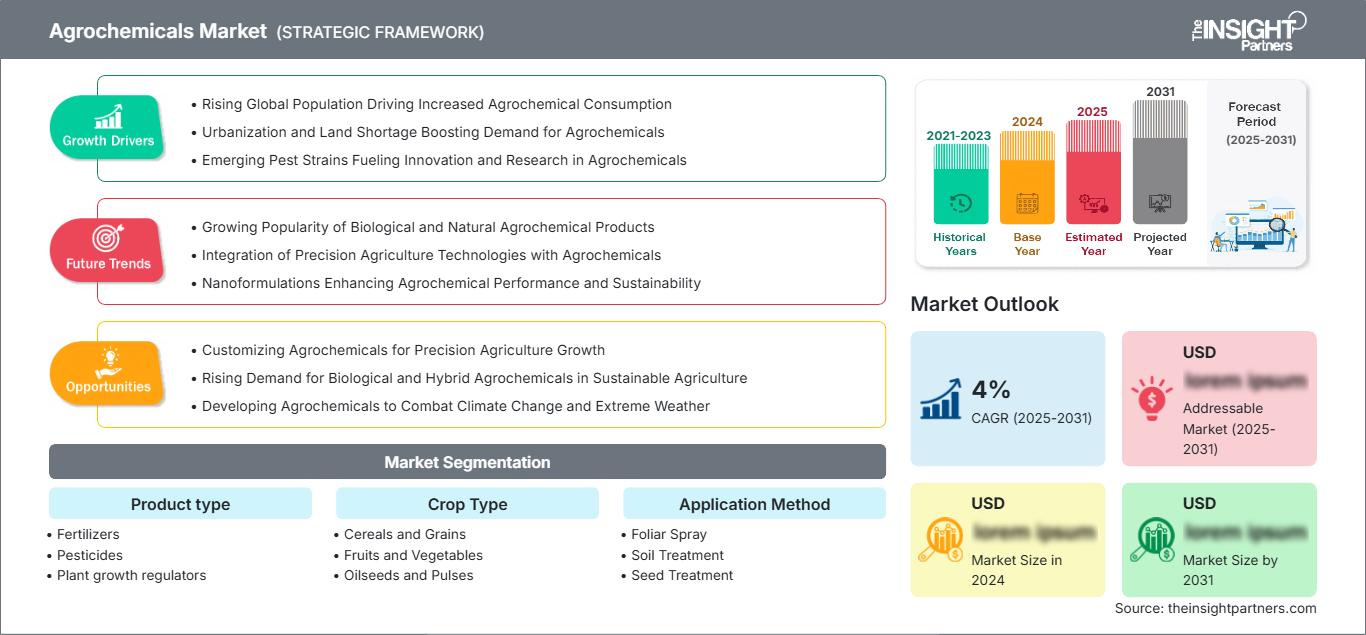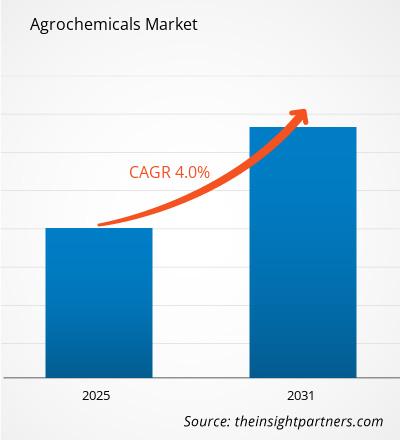Der Markt für Agrochemikalien wird voraussichtlich zwischen 2025 und 2031 eine durchschnittliche jährliche Wachstumsrate (CAGR) von 4 % verzeichnen, wobei die Marktgröße von XX Millionen US-Dollar im Jahr 2024 auf XX Millionen US-Dollar im Jahr 2031 anwachsen wird.
Der Bericht ist nach Produkttyp segmentiert (Düngemittel, Pestizide, Pflanzenwachstumsregulatoren und andere). Der Bericht enthält außerdem Analysen basierend auf der Ernteart (Getreide und Körner, Obst und Gemüse, Ölsaaten und Hülsenfrüchte und andere). Die globale Analyse ist weiter auf regionaler Ebene und nach wichtigen Ländern aufgeschlüsselt. Der Umfang umfasst die Marktgröße und -prognose auf globaler, regionaler und Länderebene für alle wichtigen Marktsegmente. Der Bericht bietet den Wert in USD für die oben genannten Analysen und Segmente. Der Bericht enthält wichtige Statistiken zum Marktstatus der wichtigsten Marktteilnehmer und bietet Markttrends und -chancen.
Zweck des Berichts
Der Bericht „Agrochemicals Market“ von The Insight Partners beschreibt die aktuelle Situation und das zukünftige Wachstum sowie die wichtigsten treibenden Faktoren, Herausforderungen und Chancen. Dadurch erhalten verschiedene Geschäftsinteressenten Einblicke, wie z. B.:
- Technologieanbieter/-hersteller: Um die sich entwickelnde Marktdynamik zu verstehen und die potenziellen Wachstumschancen zu kennen, damit sie fundierte strategische Entscheidungen treffen können.
- Investoren: Um eine umfassende Trendanalyse hinsichtlich der Marktwachstumsrate, der finanziellen Marktprognosen und der Chancen entlang der Wertschöpfungskette durchzuführen.
- Regulierungsbehörden: Um Richtlinien und Überwachungsaktivitäten auf dem Markt zu regulieren, mit dem Ziel, Missbrauch zu minimieren, das Vertrauen der Investoren zu wahren und die Integrität und Stabilität des Marktes aufrechtzuerhalten.
Agrochemikalien Marktsegmentierung Produkttyp
- Düngemittel
- Pestizide
- Pflanzenwachstumsregulatoren
Pflanzenart
- Getreide und Körner
- Obst und Gemüse
- Ölsaaten und Hülsenfrüchte
Anwendungsmethode
- Blattspray
- Bodenbehandlung
- Saatgutbehandlung
Geografie
- Nordamerika
- Europa
- Asien-Pazifik
- Süd- und Mittelamerika
- Naher Osten und Afrika
Sie erhalten kostenlos Anpassungen an jedem Bericht, einschließlich Teilen dieses Berichts oder einer Analyse auf Länderebene, eines Excel-Datenpakets sowie tolle Angebote und Rabatte für Start-ups und Universitäten.
Markt für Agrochemikalien: Strategische Einblicke

- Holen Sie sich die wichtigsten Markttrends aus diesem Bericht.Dieses KOSTENLOSE Beispiel umfasst Datenanalysen, die von Markttrends bis hin zu Schätzungen und Prognosen reichen.
Wachstumstreiber für den Agrochemikalienmarkt
- Wachsende Weltbevölkerung treibt erhöhten Agrochemikalienverbrauch: Die wachsende Weltbevölkerung und der steigende Bedarf an Nahrungsmitteln sind die Hauptfaktoren für den weltweiten Verbrauch von Agrochemikalien. Aus wirtschaftlicher Sicht müssen Landwirte aufgrund der steigenden Nachfrage mehr Pflanzen anbauen, was häufig zum Einsatz von Agrochemikalien zur Produktivitätssteigerung führt.
- Urbanisierung und Landknappheit steigern die Nachfrage nach Agrochemikalien: Da die städtische und industrielle Expansion das Angebot an Ackerland reduziert, ist es zunehmend wichtiger geworden, die Erträge der vorhandenen Flächen zu steigern. Hier kommen Agrochemikalien ins Spiel, da sie einen intensiven Anbau auf den kleinen verfügbaren Flächen ermöglichen.
- Neu auftretende Schädlingsstämme treiben Innovation und Forschung im Bereich Agrochemikalien voran: Neuer Befall von Nutzpflanzen und neue Schädlingsstämme, die den bereits verfügbaren Chemikalien widerstehen können, erfordern ständige Anpassungen der verwendeten Agrochemikalien und intensivieren somit den Forschungsaufwand in der Branche.
Zukünftige Trends im Agrochemikalienmarkt
- Steigende Beliebtheit biologischer und natürlicher Agrochemikalien: Die Verwendung biologischer und natürlicher Produkte, die in der Natur vorkommen, in der Landwirtschaft gewinnt an Bedeutung. Einige dieser biologischen Wirkstoffe sind Biopestizide, Biostimulanzien und andere biobasierte Produkte, die aufgrund ihrer Sicherheits- und Umweltvorteile immer häufiger eingesetzt werden.
- Integration von Technologien der Präzisionslandwirtschaft mit Agrochemikalien: Einer der wichtigsten Trends ist die Anwendung von Agrochemikalien in Verbindung mit Technologien der Präzisionslandwirtschaft. Intelligente Sprühgeräte, Drohnen-Applikationssysteme und KI-Systeme zur Verwaltung des Chemikalieneinsatzes sind einige der Innovationen, die unter diese Definition fallen.
- Nanoformulierungen verbessern die Leistung und Nachhaltigkeit von Agrochemikalien: Der Einsatz von Nanoformulierungen von Agrochemikalien ist neuartig. Dies bietet Vorteile wie bessere Leistung, kontrollierte Freisetzung und weniger Umweltverschmutzung.
Marktchancen für Agrochemikalien
- Anpassung von Agrochemikalien an das Wachstum der Präzisionslandwirtschaft: Es besteht ein erheblicher Spielraum für die Entwicklung von Agrochemikalien, die für die Präzisionslandwirtschaft maßgeschneidert werden. Dazu gehören Formulierungen, die mit variablen Ausbringungsratensystemen, Drohnen-Sprühsystemen und KI-gestützten Farmmanagementsystemen funktionieren.
- Steigende Nachfrage nach biologischen und hybriden Agrochemikalien in der nachhaltigen Landwirtschaft: Chancen bieten sich heutzutage auch für biologische Agrochemikalien und ihre Hybride, da der Trend zur nachhaltigen Landwirtschaft geht.
- Entwicklung von Agrochemikalien zur Bekämpfung des Klimawandels und extremer Wetterbedingungen: Die globale Erwärmung in der Landwirtschaft bietet die Möglichkeit, spezifische Arten von Agrochemikalien zu entwickeln, die speziell für den Einsatz bei extremen Wetterbedingungen für Nutzpflanzen entwickelt wurden.
Regionale Einblicke in den Agrochemikalienmarkt
Die Analysten von The Insight Partners haben die regionalen Trends und Faktoren, die den Agrochemiemarkt im Prognosezeitraum beeinflussen, ausführlich erläutert. In diesem Abschnitt werden auch die Marktsegmente und die geografische Lage in Nordamerika, Europa, dem asiatisch-pazifischen Raum, dem Nahen Osten und Afrika sowie Süd- und Mittelamerika erörtert.
Umfang des Marktberichts für Agrochemikalien
| Berichtsattribut | Einzelheiten |
|---|---|
| Marktgröße in 2024 | US$ XX million |
| Marktgröße nach 2031 | US$ XX Million |
| Globale CAGR (2025 - 2031) | 4% |
| Historische Daten | 2021-2023 |
| Prognosezeitraum | 2025-2031 |
| Abgedeckte Segmente |
By Produkttyp
|
| Abgedeckte Regionen und Länder | Nordamerika
|
| Marktführer und wichtige Unternehmensprofile |
|
Dichte der Akteure auf dem Agrochemiemarkt: Auswirkungen auf die Geschäftsdynamik verstehen
Der Markt für Agrochemikalien wächst rasant. Die steigende Nachfrage der Endverbraucher ist auf Faktoren wie veränderte Verbraucherpräferenzen, technologische Fortschritte und ein stärkeres Bewusstsein für die Produktvorteile zurückzuführen. Mit der steigenden Nachfrage erweitern Unternehmen ihr Angebot, entwickeln Innovationen, um den Bedürfnissen der Verbraucher gerecht zu werden, und nutzen neue Trends, was das Marktwachstum weiter ankurbelt.

- Holen Sie sich die Markt für Agrochemikalien Übersicht der wichtigsten Akteure
Wichtige Verkaufsargumente
- Umfassende Abdeckung: Der Bericht analysiert umfassend Produkte, Dienstleistungen, Typen und Endnutzer des Agrochemikalienmarkts und bietet einen ganzheitlichen Überblick.
- Expertenanalyse: Der Bericht basiert auf dem umfassenden Verständnis von Branchenexperten und Analysten.
- Aktuelle Informationen: Der Bericht gewährleistet Geschäftsrelevanz durch die Berichterstattung über aktuelle Informationen und Datentrends.
- Anpassungsoptionen: Dieser Bericht kann an spezifische Kundenanforderungen angepasst werden und passt sich so optimal an die Geschäftsstrategien an.
Der Forschungsbericht zum Agrochemikalienmarkt kann daher dazu beitragen, die Branchensituation und die Wachstumsaussichten zu entschlüsseln und zu verstehen. Obwohl es einige berechtigte Bedenken geben kann, überwiegen die Vorteile dieses Berichts tendenziell die Nachteile.
- Historische Analyse (2 Jahre), Basisjahr, Prognose (7 Jahre) mit CAGR
- PEST- und SWOT-Analyse
- Marktgröße Wert/Volumen – Global, Regional, Land
- Branchen- und Wettbewerbslandschaft
- Excel-Datensatz
Aktuelle Berichte
Verwandte Berichte
Erfahrungsberichte
Grund zum Kauf
- Fundierte Entscheidungsfindung
- Marktdynamik verstehen
- Wettbewerbsanalyse
- Kundeneinblicke
- Marktprognosen
- Risikominimierung
- Strategische Planung
- Investitionsbegründung
- Identifizierung neuer Märkte
- Verbesserung von Marketingstrategien
- Steigerung der Betriebseffizienz
- Anpassung an regulatorische Trends




















 Kostenlose Probe anfordern für - Markt für Agrochemikalien
Kostenlose Probe anfordern für - Markt für Agrochemikalien